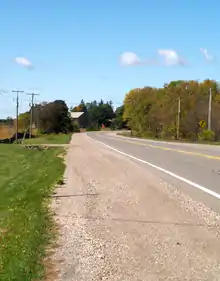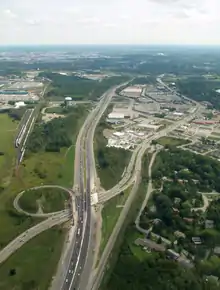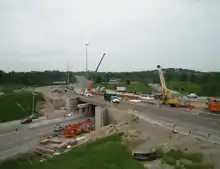Ontario Highway 8
King's Highway 8, commonly referred to as Highway 8, is a provincially maintained highway in the Canadian province of Ontario. At a length of 159.7 kilometres (99.2 mi), the route is significantly shorter than when it travelled beyond Hamilton to Niagara Falls. However, the Queen Elizabeth Way (QEW) replaced the role of Highway 8 between those two cities, and that portion of the highway was subsequently transferred from provincial to local jurisdiction. Today the highway connects Hamilton and Cambridge, thereafter continuing through Southwestern Ontario to the community of Goderich on the shores of Lake Huron. The freeway segment of Highway 8 is known as the Freeport Diversion, King Street Bypass, or Highway 8 Expressway, with a short portion previously designated by the province as Highway 7187 for internal administration. Highway 8 is concurrent with Highway 7 including a portion of the Conestoga Parkway.
| ||||||||||
|---|---|---|---|---|---|---|---|---|---|---|
| Route information | ||||||||||
| Length | 159.7 km[1] (99.2 mi) | |||||||||
| Existed | 1920–present | |||||||||
| Major junctions | ||||||||||
| West end | ||||||||||
| East end | ||||||||||
| Location | ||||||||||
| Major cities | Stratford, Kitchener, Cambridge, Hamilton | |||||||||
| Towns | Goderich, Clinton | |||||||||
| Highway system | ||||||||||
| ||||||||||
History
Provincial highway
Until 1918, the majority of the primary roads through southern Ontario formed part of the County Road System. The Department of Public Works and Highways paid up to 60% of the construction and maintenance costs for these roads, while the counties were responsible for the remaining 40%. In 1919, the federal government passed the Canada Highways Act, which provided $20,000,000 to provinces under the condition that they establish an official highway network; up to 40% of construction costs would be subsidized. The first network plan was approved on February 26, 1920, and included the Queenston Road.[2] The majority of what would soon become Highway 8 was assumed by the department over the course of the year.[3] However, it would not receive a route number until the summer of 1925.[4]
Up until the early 1970s, the highway was much longer than its current length, extending from Goderich through Kitchener-Waterloo, Cambridge, and Hamilton to Niagara Falls. However, in 1970, the Government of Ontario decided that the stretch of Highway 8 between Winona (just east of Hamilton) and Niagara Falls was no longer of major transportation significance, since by this time most traffic used the QEW, just to the north, to go between the two locales. Accordingly, the province downloaded this section of the highway to the newly formed Regional Municipality of Niagara, which designated the road as Regional Road 81. In 1998, the provincial government of Mike Harris carried another downloading of the highway to municipal authorities; this time the section between the town of Peters Corners (near Dundas) and Winona was transferred to the Regional Municipality of Hamilton-Wentworth.[5]

In 2004, extensive improvements were completed around the former obsolete and bottle-necked "half-cloverleaf" interchange of the Conestoga Parkway and the Highway 8 Expressway in Kitchener. This included a new flyover semi-directional ramp from Conestoga westbound to Highway 8 eastbound, while the ramp in the opposite direction was realigned to allow it to carry two lanes of traffic at a higher speed.
In 2002-2004 the Highway 8 Expressway was widened from four to eight lanes from the interchange to just east of Franklin Street, which necessitated moving one retaining wall and replacing the overpass which carries Franklin Street over the Highway 8 Expressway. From 2006 to 2012, there was the widening of the Highway Expressway to eight lanes past the interchange with Fairway Road (Waterloo Regional Road 53) and over the Grand River as far as the highway's next intersection with King Street about 6 km southward was undertaken. It was completed in 2012.
In September 2012, MTO completed the reconstruction of the three-road junction at Peters Corners in northern Hamilton, the eastern terminus of Highway 8, as a roundabout with separate traffic signals for the northern (Westover Road) and southeastern (Hamilton Road 8) arms.
The interchange of Highway 8 and Highway 401 is planned to be expanded, with high speed flyover ramps linking Highway 401 west of that interchange directly to the Highway 8 Expressway; at the present Highway 401 traffic west of that junction has to use King Street East for a short distance to reach the Highway 8 Expressway.[6]

Route description
Goderich–Kitchener
Highway 8 begins at its western terminus in downtown Goderich, at the junction with Highway 21. It travels eastward as a rural two-lane highway (80 km/hr speed limit) with sections running through various towns and villages functioning as normal city roads. In Stratford, it begins overlapping with Highway 7, becoming a four-lane city road before becoming a four-lane rural highway at the eastern boundary of the city and then two lanes through the village of Shakespeare. West of New Hamburg, the combined Highway 7/8 widens into four-lanes and becomes a four-lane controlled-access highway/freeway just west of Baden, and continues into Kitchener (where the 7/8 freeway is known as the Conestoga Parkway).
As the Conestoga Parkway runs through Kitchener as a six-lane freeway, Highway 8 splits off by turning southeastward via an interchange, which was opened in 1970, while Highway 7 continues on the Conestoga Parkway. Mainline traffic on Highway 8 heading northwest could continue under the Conestoga Parkway, where the route defaults to King Street, to enter downtown Kitchener or use a ramp to continue on Highway 8 by going onto the Conestoga Parkway. The eight-lane Conestoga Parkway east/north of this junction serves as a bypass of King Street through central Kitchener and Waterloo, as in the north end of Waterloo, the Conestoga Parkway and King Street intersect again.

Highway 8 continues along as eight-lane freeway, which is also known as the Freeport Diversion or King Street Bypass (but is often referred to by area residents as the Highway 8 Expressway), until another junction with King Street East after which it becomes six and then four lanes. Originally, the Highway 8 Expressway ended at an at-grade Y-junction with King Street East, with traffic from Highway 8 treated as the mainline traffic at that intersection. The Highway 8 designation continued along King Street East, a four-lane divided highway (60 km/hr speed limit) with at-grade intersections and access to adjacent commercial properties, to a cloverleaf interchange with Highway 401. In 1987, the Highway 8 Expressway was extended to provide a direct freeway link to Highway 401 eastbound, with this segment receiving the non-public designation Highway 7187 (although it is signed with Highway 8 trailblazers), as the actual Highway 8 designation remained with King Street East. As a result of the Highway 8 Expressway extension to Highway 401, the existing cloverleaf interchange between Highway 401 and King Street East was modified, with high-speed ramps directly connecting Highway 7187 to Highway 401 east of that interchange, however traffic on Highway 401 west of the interchange has to use has to use King Street East for a short distance to reach the Highway 8 Expressway. In the late 2000s, Highway 7187 was absorbed into the rerouted Highway 8 which now includes the entire freeway between the Conestoga Parkway and Highway 401, as the province decommissioned the Highway 8 designation in Kitchener-Cambridge (formerly routed along King Street East and Shantz Hill Road). To accommodate the increased traffic to/from the Highway 8 Expressway, the widening of Highway 401 from six to twelve lanes from Highway/Regional Road 8 to Highway/Regional Road 24 was completed in Summer 2019. The second phase of this project is to add direct connections from Highway 401 west of the modified cloverleaf to Highway 8 Expressway, via new high-speed flyover ramps crossing a reconfigured Highway 401 and Highway 8 junction, which will also require reconfiguration of Regional Road 38 (Sportsworld Drive) parclo interchange.[7]
Kitchener–Hamilton

The historical Highway 8 then enters Cambridge, marked as Waterloo Regional Road 8 within the boundaries of the city, following city streets such as Shantz Hill Road, Fountain Street, King Street, Coronation Boulevard, and Dundas Street. It then continues as a King's Highway out of Cambridge and into Hamilton, meeting with Highway 5 at a roundabout in Peters Corners.
Beyond this point, the road is no longer technically a King's Highway, and is officially designated as Hamilton Road 8, though numerous road signs and local custom still refer to it as Highway 8. From Peters Corners, Highway 8 continues through West Flamborough before turning south to descend the Niagara Escarpment into Dundas. In Dundas, Highway 8 follows King Street East, then turns south onto Main Street. Main Street changes names at Governor's Road to become Osler Drive. Once Highway 8 crosses the boundary into Hamilton proper, the road resumes the name Main Street.
Highway 8 continues as Main Street through the Westdale neighbourhood of Hamilton, passing McMaster University, until it reaches Paradise Road just west of Highway 403. At this point, Highway 8 splits into two roads as it passes through the Hamilton downtown core. Highway 8 eastbound follows Main Street, which becomes a multi-lane one-way street from Paradise Road until its eventual intersection with King Street near Kensington Avenue in East Hamilton. Highway 8 westbound follows King Street, which is also a multi-lane one-way street between Kensington Avenue and Paradise Road, and then briefly follows Paradise Road itself to reconnect with Main Street. East of the intersection of King Street and Main Street, the two directions of Highway 8 merge, and the highway continues to follow Main Street.
At the intersection of Main Street with Queenston Road, Highway 8 leaves Main Street and follows Queenston Road to continue its eastbound journey. East of Gray Road the designation of Queenston Road is dropped. Thereafter, the road is simply named Highway 8 until reaching Winona, where it becomes Niagara Regional Road 81.
Exit list
The following table lists the major junctions along Highway 8, as noted by the Ministry of Transportation of Ontario. Highway 8 is maintained under a Connecting Link agreement within Goderich, Clinton, Seaforth, Mitchell, and Stratford.[8]
| Division | Location | km | mi | Destinations | Notes |
|---|---|---|---|---|---|
| Huron | Goderich | 0.0 | 0.0 | Beginning of Goderich Connecting Link agreement | |
| 2.1 | 1.3 | End of Goderich Connecting Link agreement | |||
| Clinton | 18.7 | 11.6 | Beginning of Clinton Connecting Link agreement | ||
| 19.9 | 12.4 | ||||
| 20.8 | 12.9 | End of Clinton Connecting Link agreement | |||
| Seaforth | 32.3– 33.7 | 20.1– 20.9 | Seaforth Connecting Link agreement | ||
| Perth | Dublin | 43.5 | 27.0 | County Road 180 / County Road 14 North | |
| Mitchell | 49.9 | 31.0 | Beginning of Mitchell Connecting Link agreement | ||
| 52.7 | 32.7 | End of Mitchell Connecting Link agreement | |||
| Sebringville | 63.9 | 39.7 | County Road 135 north | ||
| Stratford | 69.6 | 43.2 | Beginning of Stratford Connecting Link agreement | ||
| 75.4 | 46.9 | Beginning of Highway 7 concurrency | |||
| 78.4 | 48.7 | End of Stratford Connecting Link agreement | |||
| Perth–Waterloo boundary | Shakespeare | 87.1 | 54.1 | County Road 107 | Formerly |
| Waterloo | New Hamburg | 95.2 | 59.2 | Regional Road 1 | New Hamburg Bypass |
| 98.4 | 61.1 | Regional Road 4 west (Peel Street) | |||
| Wilmot | 99.2 | 61.6 | Regional Road 4 east (Bleams Road) | ||
| 100.7 | 62.6 | Regional Road 5 north (Nafziger Road) | |||
Controlled-access highway begins 1.4 km (0.87 mi) east of Nafziger Road | |||||
| Waterloo | Wilmot | 102.9 | 63.9 | Regional Road 51 (Foundry Street) – Wilmot Centre | |
| 107.7 | 66.9 | Regional Road 12 (Queen Street (south) / Notre Dame Drive (north)) – Petersburg | |||
| 111.6 | 69.3 | Regional Road 70 (Trussler Road) – Mannheim | |||
| Kitchener | |||||
| 114.5 | 71.1 | Regional Road 58 (Fischer Hallman Road) | |||
| 117.1 | 72.8 | Regional Road 28 (Homer Watson Boulevard) | Eastbound entrance via Ottawa Street South | ||
| 118.4 | 73.6 | Courtland Avenue | |||
| 119.8 | 74.4 | Highway 8 exits Conestoga Parkway onto Freeport Diversion; end of Highway 7 concurrency | |||
| 122.0 | 75.8 | Weber Street, Fairway Road | |||
| 124.5 | 77.4 | Regional Road 8 (King Street) – Cambridge, London | Eastbound exit and westbound entrance; former route of Highway 8 | ||
| 128.4 | 79.8 | Regional Road 38 (Sportsworld Drive, Maple Grove Road) | |||
| 130.5 | 81.1 | Eastbound exit and westbound entrance; Highway 8 is regionally maintained through Cambridge as Regional Road 8. | |||
| Cambridge | 141.5 | 87.9 | Regional Road 43 (Branchton Road) | Highway 8 resumes | |
| Hamilton | Rockton | 153.3 | 95.3 | Regional Road 552 (Kirkwall Road) – Kirkwall | Beginning of former Highway 52 concurrency |
| Peters Corners | 159.5 | 99.1 | Westover Road | End of former Highway 52 concurrency | |
| 159.7 | 99.2 | ||||
1.000 mi = 1.609 km; 1.000 km = 0.621 mi
| |||||
References
Footnotes
- Ministry of Transportation of Ontario, 2004 Annual Average Daily Traffic Archived 2017-12-17 at the Wayback Machine
- Shragge 1984, pp. 73–75.
- Annual Report (Report). Department of Public Highways. March 31, 1921. pp. 40–45.
- "Provincial Highways Now Being Numbered". The Canadian Engineer. Monetary Times Print. 49 (8): 246. August 25, 1925.
Numbering of the various provincial highways in Ontario has been commenced by the Department of Public Highways. Resident engineers are now receiving metal numbers to be placed on poles along the provincial highways. These numbers will also be placed on poles throughout cities, towns and villages, and motorists should then have no trouble in finding their way in and out of urban municipalities. Road designations from "2" to "17" have already been allotted...
- Ontario Highway 8 History - The King's Highways of Ontario
- https://urbantoronto.ca/forum/threads/roads-highway-401-widening-highway-8-to-highway-410-mto-u-c-planned.10054/page-59
- Contract Management and Operations Branch (2011). Connecting Links (Report). Ministry of Transportation of Ontario. p. 3.
External links
| Wikimedia Commons has media related to Ontario Highway 8. |


